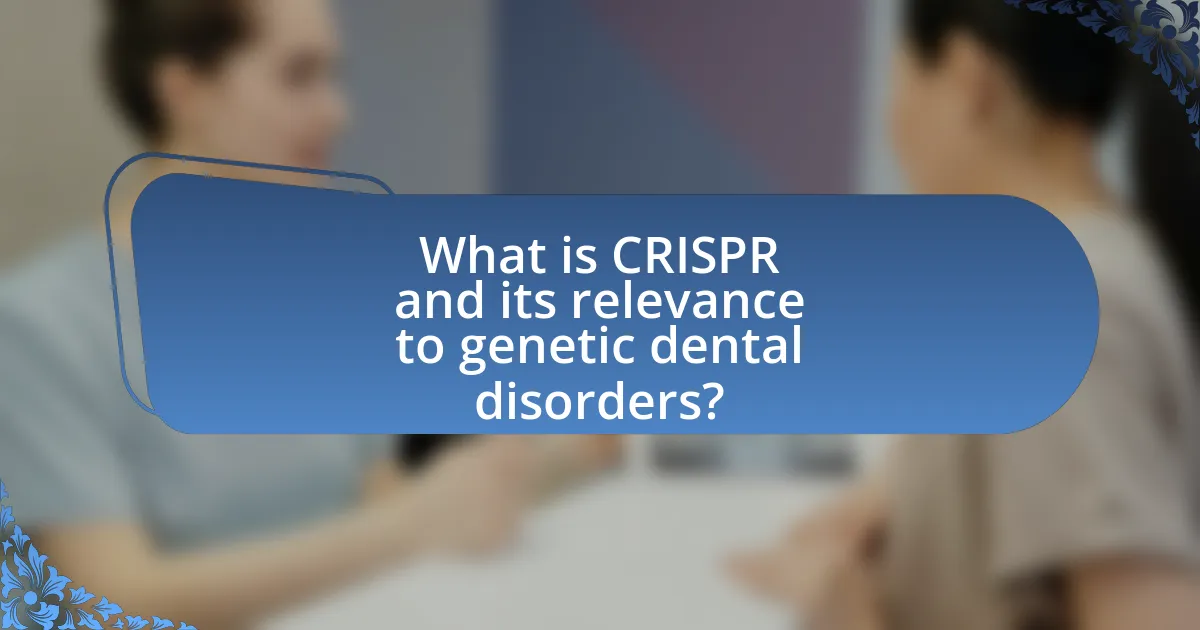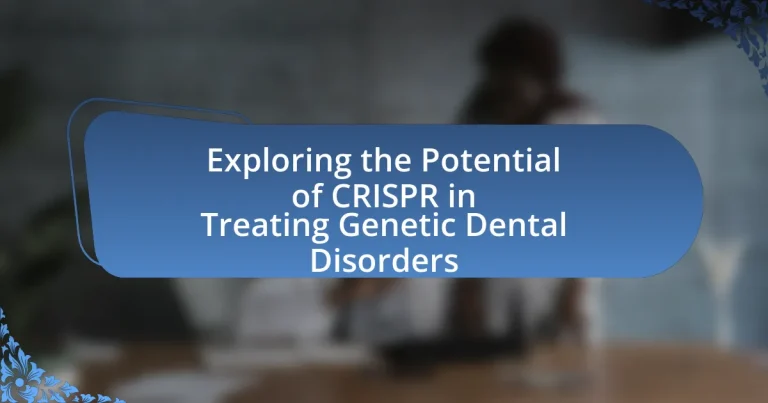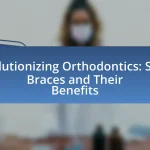CRISPR is a groundbreaking gene-editing technology with significant implications for treating genetic dental disorders such as amelogenesis imperfecta and dentinogenesis imperfecta. This article explores how CRISPR functions, its key components, and its ability to target specific genes associated with various dental conditions. It also addresses the potential risks, ethical considerations, and regulatory challenges surrounding the application of CRISPR in dental genetics. Furthermore, the article highlights the importance of collaboration between researchers and dental practitioners, as well as the need for ongoing education to keep professionals informed about advancements in CRISPR technology.

What is CRISPR and its relevance to genetic dental disorders?
CRISPR is a revolutionary gene-editing technology that allows for precise modifications of DNA sequences in living organisms. Its relevance to genetic dental disorders lies in its potential to correct mutations responsible for conditions such as amelogenesis imperfecta and dentinogenesis imperfecta, which affect tooth development and structure. Studies have demonstrated that CRISPR can effectively target and edit genes associated with these disorders, offering a promising avenue for therapeutic interventions. For instance, research published in the journal “Nature Biotechnology” by Liu et al. (2019) highlights successful applications of CRISPR in correcting genetic defects in animal models, indicating its viability for future treatments in humans.
How does CRISPR technology function in gene editing?
CRISPR technology functions in gene editing by utilizing a guide RNA to direct the Cas9 enzyme to a specific DNA sequence, where it creates a double-strand break. This break activates the cell’s natural repair mechanisms, which can be harnessed to introduce desired genetic changes, such as correcting mutations or inserting new genes. The precision of CRISPR is evidenced by its ability to target specific sequences with high accuracy, as demonstrated in studies where it successfully edited genes in various organisms, including plants and animals, leading to advancements in genetic research and potential therapeutic applications.
What are the key components of the CRISPR system?
The key components of the CRISPR system are the Cas proteins, guide RNA (gRNA), and the target DNA sequence. Cas proteins, such as Cas9, act as molecular scissors that cut DNA at specific locations. The guide RNA directs the Cas protein to the target DNA sequence by complementary base pairing, ensuring precise editing. This system was originally discovered in bacteria as a defense mechanism against viruses, demonstrating its natural role in adaptive immunity.
How does CRISPR target specific genes related to dental disorders?
CRISPR targets specific genes related to dental disorders by utilizing a guide RNA that matches the DNA sequence of the target gene, allowing the Cas9 enzyme to create a double-strand break at that precise location. This mechanism enables researchers to edit genes associated with conditions such as amelogenesis imperfecta and dentinogenesis imperfecta, which are linked to enamel and dentin formation. Studies have demonstrated the effectiveness of CRISPR in modifying genes in dental stem cells, leading to potential advancements in regenerative dentistry and the treatment of genetic dental disorders.
What types of genetic dental disorders can CRISPR potentially treat?
CRISPR has the potential to treat various genetic dental disorders, including amelogenesis imperfecta, dentinogenesis imperfecta, and hypophosphatasia. Amelogenesis imperfecta is characterized by abnormal enamel formation, leading to weak and discolored teeth. Dentinogenesis imperfecta involves defective dentin, resulting in brittle teeth that are prone to fractures. Hypophosphatasia affects the mineralization of bones and teeth, causing dental issues and early tooth loss. Research indicates that CRISPR can target and modify the genes responsible for these conditions, offering a promising avenue for treatment.
Which genetic mutations are commonly associated with dental disorders?
Genetic mutations commonly associated with dental disorders include mutations in the MSX1, PAX9, and AXIN2 genes. These mutations can lead to conditions such as hypodontia, which is characterized by the absence of one or more teeth. Research has shown that MSX1 mutations are linked to tooth agenesis, while PAX9 mutations are associated with both hypodontia and oligodontia. Additionally, AXIN2 mutations have been implicated in familial tooth agenesis. These findings highlight the genetic basis of dental disorders and the potential for targeted therapies, such as CRISPR, to address these genetic issues.
How do these disorders impact dental health and overall well-being?
Genetic dental disorders significantly impact dental health and overall well-being by leading to malformations, increased susceptibility to cavities, and periodontal disease. These disorders can cause structural abnormalities in teeth and jaws, resulting in misalignment and difficulty in chewing, which can affect nutrition and overall health. For instance, conditions like amelogenesis imperfecta lead to enamel defects, making teeth more prone to decay and sensitivity. Furthermore, the psychological effects of having visible dental issues can lead to low self-esteem and social anxiety, further diminishing quality of life. Studies indicate that individuals with untreated dental disorders often experience chronic pain and discomfort, which can contribute to broader health issues such as cardiovascular disease due to the systemic effects of oral infections.
What are the ethical considerations surrounding CRISPR in dental treatments?
The ethical considerations surrounding CRISPR in dental treatments include concerns about genetic modification, consent, and potential long-term effects. Genetic modification raises questions about the appropriateness of altering human DNA, particularly in germline editing, which can affect future generations. Informed consent is crucial, as patients must fully understand the implications of CRISPR treatments, including risks and benefits. Additionally, the potential for unintended consequences, such as off-target effects or ecological impacts, necessitates careful ethical scrutiny. These considerations are underscored by guidelines from organizations like the National Institutes of Health, which emphasize the importance of ethical oversight in gene editing research and applications.
What are the potential risks of using CRISPR in humans?
The potential risks of using CRISPR in humans include off-target effects, unintended genetic mutations, and ethical concerns regarding germline editing. Off-target effects occur when CRISPR inadvertently modifies genes other than the intended target, which can lead to harmful consequences, such as cancer or other genetic disorders. A study published in Nature Biotechnology by Tsai et al. (2015) demonstrated that CRISPR can cause unintended edits in the genome, highlighting the need for precision in gene editing. Additionally, ethical concerns arise from germline editing, which alters heritable traits and raises questions about the long-term implications for future generations. These risks necessitate careful consideration and regulation in the application of CRISPR technology in humans.
How do regulations affect the application of CRISPR in dental genetics?
Regulations significantly impact the application of CRISPR in dental genetics by establishing guidelines for safety, efficacy, and ethical considerations. Regulatory bodies, such as the FDA in the United States, require extensive preclinical and clinical testing to ensure that CRISPR-based therapies are safe for human use, which can delay the development and implementation of these technologies. For instance, the FDA’s oversight mandates that any genetic modification intended for therapeutic use must undergo rigorous evaluation, including assessments of off-target effects and long-term outcomes. This regulatory framework aims to protect patients while also fostering innovation, but it can create barriers that slow down the translation of CRISPR research into clinical practice in dentistry.
How can CRISPR be integrated into current dental practices?
CRISPR can be integrated into current dental practices by utilizing its gene-editing capabilities to address genetic dental disorders, such as amelogenesis imperfecta and dentinogenesis imperfecta. This integration involves developing targeted therapies that correct genetic mutations responsible for these conditions, potentially improving patient outcomes. Research has demonstrated that CRISPR can effectively modify genes in various cell types, including dental pulp stem cells, which can lead to advancements in regenerative dentistry and personalized treatment plans. For instance, a study published in the journal “Nature Biotechnology” by Liu et al. (2019) highlighted the successful application of CRISPR in correcting genetic defects in human cells, showcasing its potential for therapeutic use in dental applications.
What are the challenges in implementing CRISPR for dental disorders?
The challenges in implementing CRISPR for dental disorders include off-target effects, delivery mechanisms, ethical concerns, and regulatory hurdles. Off-target effects can lead to unintended genetic modifications, which may cause adverse outcomes. Effective delivery mechanisms are crucial, as the oral environment presents unique obstacles for gene editing tools to reach target cells. Ethical concerns arise regarding the modification of human germline cells, which could have long-term implications for future generations. Additionally, navigating the regulatory landscape for gene editing technologies poses significant challenges, as existing frameworks may not adequately address the complexities of CRISPR applications in dentistry.
What technological advancements are needed for effective application?
For effective application of CRISPR in treating genetic dental disorders, advancements in precision gene editing technologies, delivery mechanisms, and regulatory frameworks are essential. Precision gene editing technologies must enhance accuracy to minimize off-target effects, ensuring that only the intended genetic modifications occur. Improved delivery mechanisms, such as viral vectors or nanoparticles, are necessary to efficiently transport CRISPR components into specific dental tissues. Additionally, regulatory frameworks must evolve to address ethical considerations and safety protocols, facilitating clinical trials and eventual therapeutic use. These advancements are crucial for translating CRISPR technology from research into practical applications in dentistry.
How can dental professionals prepare for CRISPR integration?
Dental professionals can prepare for CRISPR integration by enhancing their understanding of genetic engineering and its applications in dentistry. This preparation involves engaging in specialized training programs focused on CRISPR technology, which can provide insights into gene editing techniques relevant to treating genetic dental disorders. Furthermore, professionals should stay updated on the latest research and clinical trials involving CRISPR, as this knowledge will inform their practice and patient care strategies. For instance, studies have shown that CRISPR can effectively target genes associated with conditions like amelogenesis imperfecta, highlighting its potential in dental applications. By actively participating in workshops and collaborating with geneticists, dental professionals can ensure they are equipped to implement CRISPR-based solutions safely and effectively in their practices.
What future developments can we expect in CRISPR research for dental disorders?
Future developments in CRISPR research for dental disorders include advancements in gene editing techniques that target specific genetic mutations responsible for conditions such as amelogenesis imperfecta and dentinogenesis imperfecta. Researchers are focusing on improving the precision and efficiency of CRISPR systems, such as CRISPR-Cas9 and CRISPR-Cas12, to minimize off-target effects and enhance therapeutic outcomes. For instance, studies have demonstrated that optimized CRISPR systems can effectively correct genetic defects in vitro, paving the way for potential clinical applications in dental genetics. Additionally, ongoing research is exploring the use of CRISPR in combination with stem cell therapy to regenerate dental tissues, which could revolutionize treatment approaches for various dental disorders.
How might CRISPR change the landscape of dental genetics in the next decade?
CRISPR is poised to revolutionize dental genetics by enabling precise gene editing to address genetic dental disorders. In the next decade, advancements in CRISPR technology will facilitate the correction of mutations responsible for conditions such as amelogenesis imperfecta and dentinogenesis imperfecta, leading to improved patient outcomes. Studies have demonstrated CRISPR’s efficacy in targeting specific genes, as seen in research published in Nature Biotechnology, where scientists successfully corrected genetic defects in dental tissues in animal models. This capability will not only enhance treatment options but also pave the way for personalized dental care, ultimately transforming the management of hereditary dental conditions.
What role will collaboration between researchers and dental practitioners play?
Collaboration between researchers and dental practitioners will play a crucial role in advancing the application of CRISPR technology for treating genetic dental disorders. This partnership enables the integration of cutting-edge research findings into clinical practice, ensuring that innovative treatments are effectively translated to patient care. For instance, researchers can provide dental practitioners with the latest insights on gene editing techniques, while practitioners can offer real-world feedback on treatment efficacy and patient outcomes. Such collaboration has been shown to enhance the development of targeted therapies, as evidenced by studies indicating that interdisciplinary approaches lead to more effective treatment protocols in genetic conditions.
What practical steps can dental professionals take to stay informed about CRISPR advancements?
Dental professionals can stay informed about CRISPR advancements by subscribing to relevant scientific journals, attending conferences focused on genetic research, and participating in online courses or webinars that cover CRISPR technology. For instance, journals like “Nature Biotechnology” and “The CRISPR Journal” publish peer-reviewed articles on the latest developments in CRISPR research. Additionally, conferences such as the CRISPR 2023 Summit provide networking opportunities and insights from leading experts in the field. Engaging in continuing education programs can also enhance understanding of CRISPR applications in dentistry, ensuring that professionals remain updated on breakthroughs and clinical implications.


